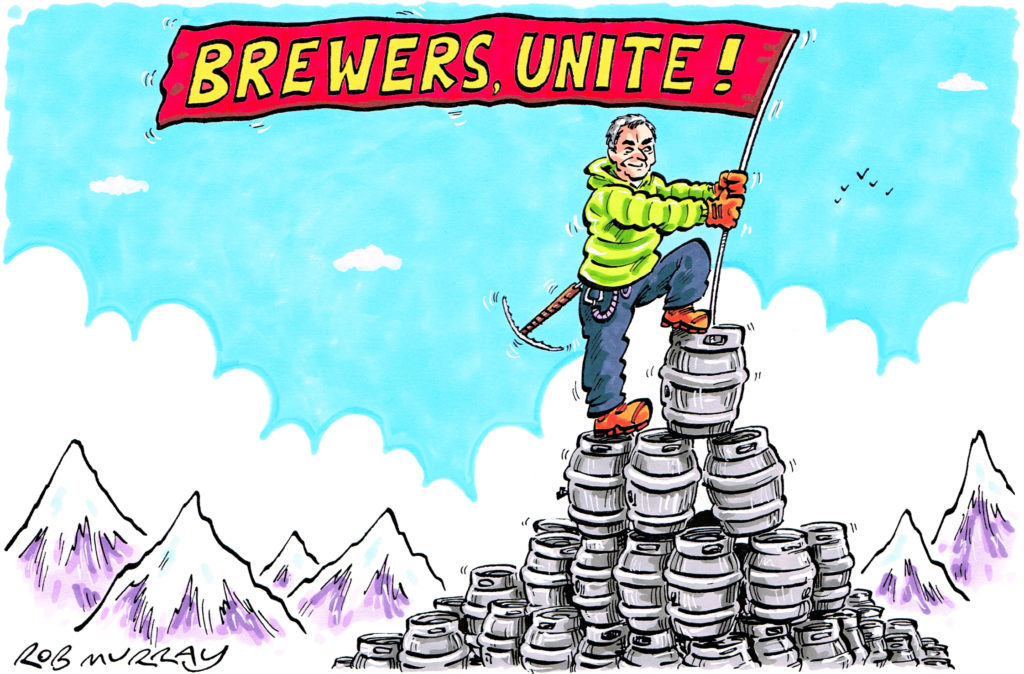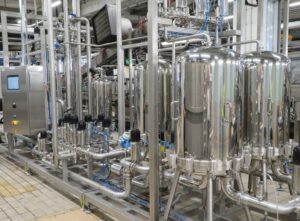I am shortly to become a retired brewer. I have worked for a very big brewer (Watneys) and a small brewer (Fuller’s). It always amuses me when people use those terms. They really don’t have any meaning. To a brewer who brews 5000 hl per year Fuller’s is huge (about 330,000 hl, if you must ask). However, if you are Carlsberg, Fuller’s is almost insignificant.
I read a book once – I think it was by Somerset-Maugham or maybe J B Priestly (well it was a long time ago) – in which a number of people got into a railway carriage. Many were going to the same convention, one of them worked for a company making self-adhesive tape another in glue and another in gum (this was written in the ‘50s). They did nothing but argue. When they all got off, the people remaining in the carriage looked at each other. Finally, one of them said: “Funny, I thought they would all have stuck together.”
Sometimes I feel that about the brewing industry. Craft v tradition. Keg v cask. Big brewer v small brewer. If only it was that simple. Instead, we have medium sized brewer v small brewer, slightly bigger brewer v small brewer and tiny brewer v small brewer. The consumer (hereafter referred to as the drinker) wants one thing – beer he or she enjoys.
Today the industry appears to be more fractious than the one I joined in 1974. Why is that? First, there are more breweries. Secondly, in ’74 brewers were concerned with brewing, the selling side rarely impinged itself on the minds of the brewers. In the smaller breweries today, the brewer is often the sales director too. Competition is keenly felt. If you lose a bar handle to another brewery, even if they are your friends, it still hurts. Also, supply is now much bigger than demand therefore competition is more intense.
I was talking to someone last week. They referred to the British Brewing industry as a “basket case” because nobody is making money. If that is the case, then a number of breweries will go out of business. But we have been saying that for a few years now and it still hasn’t happened. The bigger issue is that we aren’t working together to address this. Instead, big blames small and vice versa.
But, it is not all doom and gloom. The drinker today has never had more choices. The brewer is firmly established as the most important person in a brewery. Flavour is king and brewers know flavour better than anyone. Organisations, like the London Brewers’ Alliance, help each other and generate a brotherhood of brewers though its meetings. It has become fun to be a brewer and collaborations have become de rigueur.
I think the brewing business is crying out for leadership. Someone who can see both sides of the argument (they are always two sides to an argument). My own hope is that SIBA and CAMRA grasp this nettle. Why them? Because by and large SIBA represent the brewers that make the beer I am most interested in. I will lay my cards on the table and just simply say I have never been interested in making or drinking standard lager. The beer is just not to my taste; this does not make it a bad beer, just a beer I do not like. I am, like every other person in this world, quite capable of bias.
And why CAMRA? Well it is the only relevant consumer organisation. The drinkers’ voice must be heard too. Who else can represent the drinker and pub goer? They also represent the traditional beer of Britain, cask ale.
Again, my bias comes to the fore.
Ultimately, I just want someone to try to mend the factions.
Take for instance the debate on keg v cask – or evil v good as some people think. It is perfectly possible to get a bad pint of cask and a great pint of keg and vice versa. Generally, keg beer is served colder and fizzier than cask. Temperature will change the way you perceive flavour and guess what, carbon dioxide also changes the way you perceive flavour. Now given that there are so many different flavours in the world of beer, it would be logical to assume that some flavours suit keg and some suit cask. One is not better than the other, just different.
Keg is far more popular than cask. There are obvious reasons for this. It has a longer shelf life, it is easier to look after in the pub, but above all it has a bigger margin both for retail and the brewer. Currently it is also far sexier. This is because it is the container of the craft beer revolution – if only Americans could make cask beer then that, too, would be sexy.
Cask also has its advantages. It is the least processed of all beers and therefore processes the most natural flavours. A brewer at Bass told me a long time ago that cask beer has better drinkability than keg. He reasoned that this was to do with the yeast – and I agree with him. A beer that has been separated from its yeast for six months has less drinkability than a beer that has been fined just 24 hours ago.
Craft beer has further blurred things by effectively putting unfiltered beer in a keg. Is this cask beer in a keg or a new hybrid? Mind you, Watneys put cask beer in kegs in the 1980s. Innovation? Or, is it just rediscovery of the past as brewing historian Ron Pattinson and I call it?
So, in conclusion, we must unite behind the issues that we have in common rather than fight over the problems that divide us. When we are all on the plane to the next CBC convention in America, the other passengers might end up saying how wonderful it is to see all the various brewers sticking together.
Have an issue you want John to discuss? Email dearjohn@brewersjournal.info









